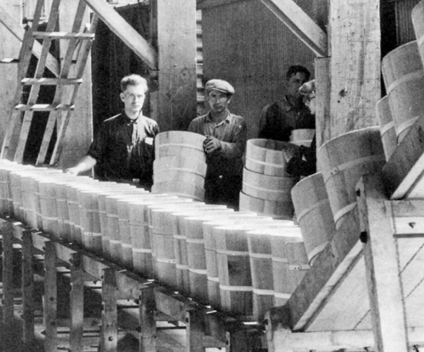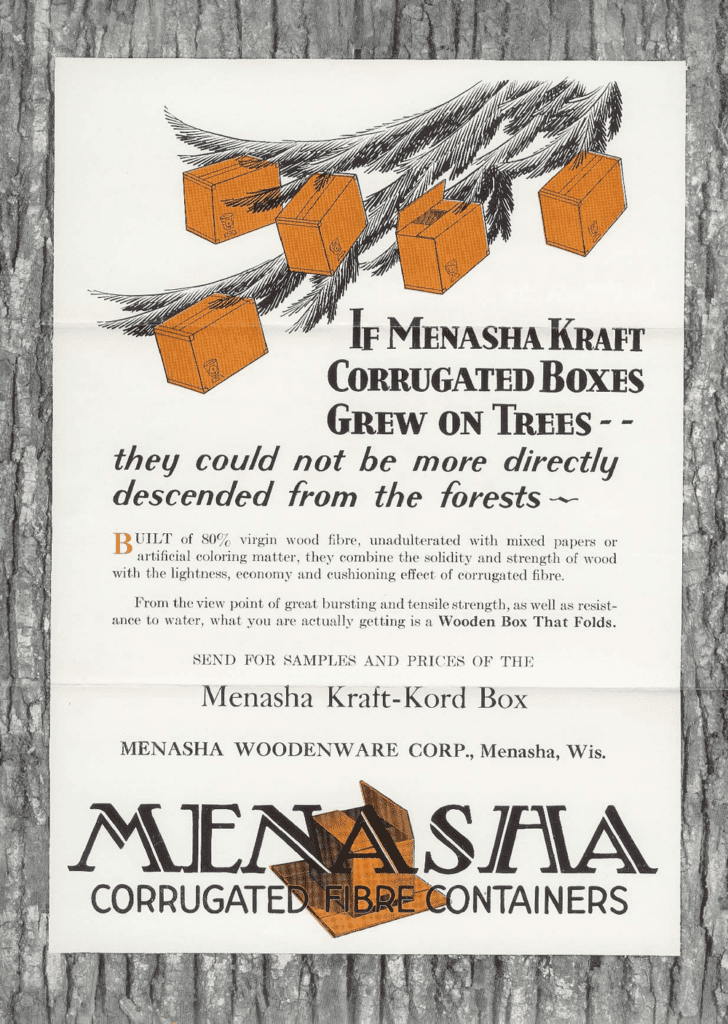Powered by Menasha Corporation
With humble beginnings as a wooden pail factory in 1849, Menasha is now one of the oldest and most successful, family-owned manufacturing businesses in the country—mainly due to our willingness to evolve and innovate to meet customer needs.
In the 19th century, barrels and other wooden containers were the dominant means of shipping goods to market. Responding to consumer needs, a small wooden pail factory opened in Menasha, Wisconsin. But after two sets of owners, the company failed to earn a profit.
A packaging revolution was taking place in the early 1900s and Menasha entered the corrugated packaging business. Thus begins the story of Menasha Corporation, which ultimately led to Menasha.
The History of Menasha
1800s
Elisha Smith buys a tiny, struggling wooden pail factory.
During the Civil War, the Pail Factory becomes the largest manufacturer of woodenware in Wisconsin.
The business is incorporated under the name Menasha Wooden Ware and is now the largest woodenware manufacturer in the Midwest, and perhaps even in the U.S.

1900s
Manufacturers shift to consumer-sized packaging made of paperboard, glass, and other materials.
Menasha Corporation enters the corrugated box business.
New Jersey Packaging, specializing in pressure-sensitive and heat-seal labels for the pharmaceutical and health care industries, is acquired by Menasha Corporation.
Menasha Corporation is reorganized into seven business groups, including the Packaging Group, now known as Menasha.
G. B. Lewis, a manufacturer of plastics, is acquired. This plastic container plant becomes the platform for Menasha’s early growth in plastics.

Menasha Corporation opens the only plant in the industry devoted exclusively to making plastic pallets.
Menasha Services is established to work with other Menasha divisions to provide customers with information based on logistics and supply chain services in various markets: auto subassembly, non-auto assembly, limited menu foodservice, bulk produce, and pharmaceuticals.
2000s
In recent years, changes to the way products are packaged have been driven by a range of factors, including sustainability, e-commerce and brand loyalty. These innovations have come in all shapes and sizes — from packaging that can be eaten after use to augmented reality products designed to tell a consumer a company’s story.3
Strategic acquisitions in Pennsylvania give Menasha entry into the food market with folding cartons for supermarket in-store bakeries and delis, and modular display containers used widely throughout the confectionary industry.
Menasha launches the Retail Integration Institute (RII), a strategic initiative focused on developing relationships and understanding of channel-leading retailers. The knowledge and insights are leveraged with CPG customers to operate more strategically at retail.
As part of a major rebranding effort, Menasha streamlines the company’s internal divisions into the following groups: Packaging, Display, Folding Carton, PrePrint, Food, Retail Integration Institute, Healthcare, Global, and Services.
Making its long-standing commitment to sustainability, Menasha releases its inaugural sustainability report.
Entering the services business
Menasha acquires The Strive Group, enhancing its manufacturing and supply chain services offering.
Menasha acquires Rand Diversified, enriching product and service offerings on the East Coast.
Menasha acquires Strine Printing Company, providing increased coverage for promotional print services.
Menasha acquires PearceWellwood and Portable Packaging, entering the Canadian market.
Menasha acquires ARI Packaging, adding to its contract packaging and fulfillment capabilities.
Menasha implements an employee-first approach, with rapid and coordinated protocol efforts to ensure the safety of people across the network. Menasha also packs and ships millions of Covid-19 test kits to retailers across North America.
Menasha launches a North American network focused on helping brands connect their omnichannel experience with seamless, multichannel execution, in-store and online out of one facility.
Menasha acquires Color-Box, strengthening its portfolio of graphic packaging solutions.
Menasha Corporation, the parent company of Menasha Packaging, celebrates 175 years of packaging and supply chain leadership.
1,2ohioline.osu.edu/factsheet/cdfs-133
3www.nspackaging.com/analysis/packaging
©2025 Menasha Packaging Company, LLC. All rights reserved.
We use cookies to give you the best online experience. Cookies keep our site secure and reliable and let us personalize your website experience. To learn more about cookies, including steps for disabling, view our privacy policy. By clicking “OK” on this banner you consent to the use of cookies unless you disable them.
We use cookies to give you the best online experience. Cookies keep our site secure and reliable and let us personalize your website experience. To learn more about cookies, including steps for disabling, view our privacy policy. By clicking “OK” on this banner you consent to the use of cookies unless you disable them.